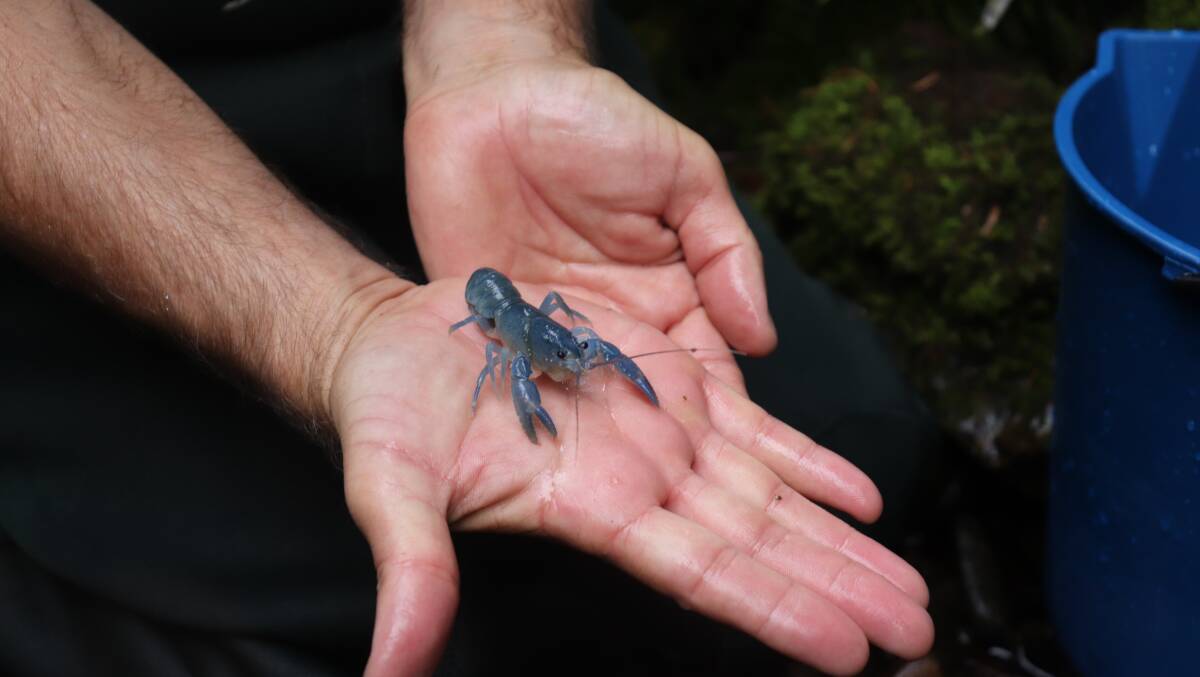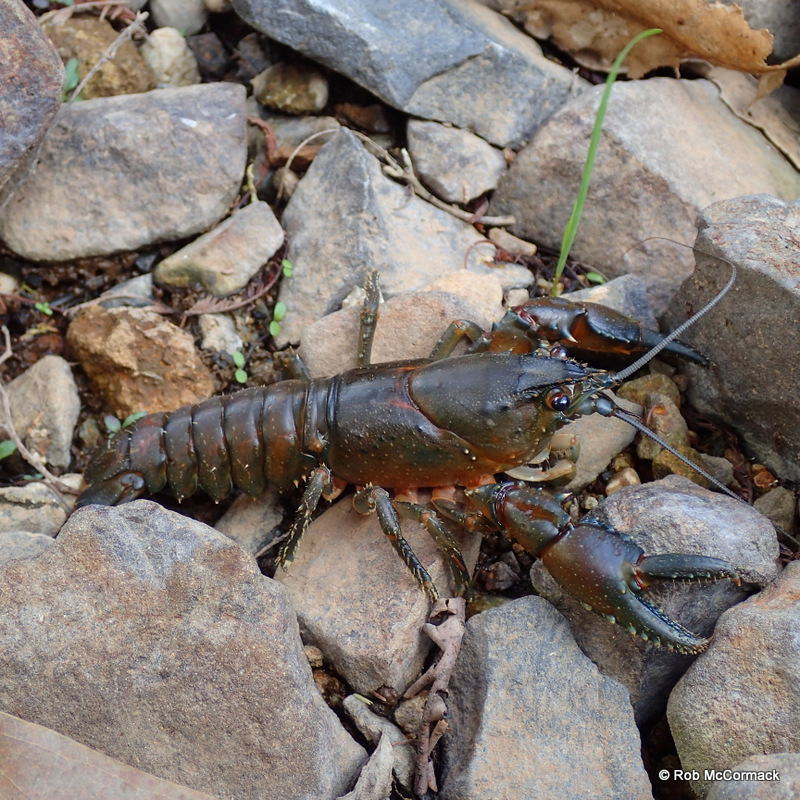
The Tasmanian Giant Freshwater Crayfish, which can grow to the size of many lobster species and
This video by Flakemore Fishing shows footage of the Tasmanian freshwater crayfish.The Tasmanian giant freshwater crayfish (Astacopsis gouldi), also called T.

Tasmanian Crayfish Profile. The Largest Crayfish in the World Shrimp and Snail Breeder
The Giant Freshwater Crayfish (Astacopsis gouldi) is the largest freshwater crayfish in the world, and is found only in rivers in the north of Tasmania. Mature adults are capable of reaching 6 kg in weight, although 2-3 kg animals are now considered large.

Tasmanian giant freshwater crayfish surveys North Barker Ecosystem Services
The Tasmanian giant crayfish is the largest crayfish in the world. This crayfish is classified under Astacopsis; a genus of freshwater crayfish endemic to the island of Tasmania.

The Tasmanian Giant Freshwater Crayfish, the largest freshwater invertebrate in the world r
The giant Tasmanian freshwater crayfish Astacopsis gouldi prized by fisherman, is the world's largest freshwater invertebrate.Astacopsis gouldi is known only from river drainages in northern Tasmania. A narrow distribution, pollution of habitat and over-harvesting has led to the rapid decline of populations and subsequent loss from a number of drainages.

Cool Goby Blog Tasmanian Giant Freshwater Crayfish Astacopsis gouldi
Key points: The giant freshwater crayfish is a threatened species only found in northern Tasmania The species has historically been poached, one of multiple reasons for its declining population Work is underway in Tasmania's north-west to rebuild the crayfish's habitat

Tasmanian giant freshwater crayfish surveys North Barker Ecosystem Services
Astacopsis gouldi Tasmanian giant freshwater lobster (Also: giant freshwater crayfish) By Bill McClain Geographic Range Habitat Physical Description Reproduction Behavior Food Habits Economic Importance for Humans: Positive Conservation Status Contributors References Geographic Range

The Tasmanian Giant Freshwater Lobster Astacopsis gouldi The Australian Crayfish Project
Tasmanian Freshwater Burrowing Crayfish (420Kb) To the west two of the robust species are E. fossor and E. cisternarius, extending from below Macquarie Harbour in the south west through nearly to Devonport on the north coast. In the east the most widespread is E. mairener found from Wesley Vale through to Mt William National Park in the northeast.

In a world first, Tasmanian giant freshwater crayfish released into wild Bega District News
At an undisclosed location in Tasmania's North-East, about 60 juvenile captive-reared giant freshwater crayfish, also known as giant freshwater lobster, have been released into the wild. Sarah Davison Journalist Education reporter at The Examiner, with an additional focus on issues affecting the LGBTQIA+ community.

"Big Crayfish on a Pot at Marion Bay in Tasmania" by andychiz Redbubble
The Tasmanian giant freshwater crayfish ( Astacopsis gouldi ), also called Tasmanian giant freshwater lobster, is the largest freshwater invertebrate and the largest freshwater crayfish species in the world. The species is only found in the rivers below 400 metres (1,300 ft) above sea level in northern Tasmania, an island-state of Australia.

The Giant Tasmanian Freshwater Lobster Astacopsis gouldi
ABC Rural Tasmanian farmers step in to save giant freshwater crayfish ABC Northern Tasmania / By Meg Powell Posted Tue 8 Nov 2022 at 11:38am, updated Thu 17 Nov 2022 at 1:59pm Fiona Marshall has planted hundreds of trees on farming properties in north-west Tasmania in an effort to protect the rivers.
Tasmanian giant freshwater lobster Clock ticking for 'iconic' animal, experts say ABC News
The Tasmanian giant freshwater crayfish (Astacopsis gouldi) is the largest freshwater invertebrate in the world, capable of growing to over 80 centimetres in length and weighing up to six kilograms.Endemic to northern Tasmania, it is only found in rivers that flow into Bass Strait and the Arthur catchment (except for the Tamar catchment) and is culturally significant to the Tasmanian.

Tasmanian giant freshwater crayfish (A.Gouldi) Endangered Crayfish, Tasmanian, Endangered
It is home to the world's three largest freshwater crayfish: the Tasmanian giant freshwater crayfish Astacopsis gouldi, which can achieve a mass over 5 kg (11 lb) and is found in rivers of northern Tasmania; the Murray crayfish Euastacus armatus, which can reach 2.5 kg (5.5 lb), although reports of animals up to 3 kg (6.6 lb) have been made
Landcare group fights to stop Tasmanian giant freshwater crayfish roadkill ABC News
One of the highlights of the 2017 BioBlitz was the discovery of an uncommonly large, giant Tasmanian freshwater crayfish ( Astacopsis gouldi ), known locally as a "lobster". The encounter features.

Tasmanian giant freshwater crayfish surveys North Barker Ecosystem Services
The third genus Astacopsis is found only in Tasmania and includes Astacopsis gouldi or the Giant Tasmanian Crayfish and is not only the largest crayfish in the world but is also believed to be the largest freshwater crustacean. Although large animals are now rare, specimens have been recorded to weigh in excess of 6 kg, and measuring over 400.

Tasmanian Giant Freshwater Crayfish, Cherax, blue Crayfish, astacidea, common Yabby, Cherax
These rivers are the home of a little known, but iconic Tasmanian animal - the endangered giant freshwater crayfish, or to give it its scientific name, the Astacopsis gouldi. These animals are true 'river monsters'. They live for up to 80 years and can reach a massive size, almost a metre in length and weigh up to six kilograms.

Seeing Is Believing The Tasmanian Giant Crawfish
The Tasmanian giant freshwater crayfish (Astacopsis gouldi), also called Tasmanian giant freshwater lobster, is the largest freshwater invertebrate in the world. The species is only found in the rivers below 400 metres (1,300 ft) above sea level in northern Tasmania, an island-state of Australia. It is listed as an endangered species on the IUCN Red List due to overfishing and habitat.
